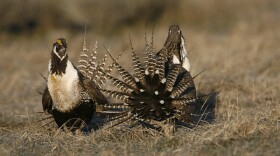The sage grouse relies on large tracts of unbroken sagebrush habitat, miles of scrubby bushes flowing like an ocean, unbroken by towns and roads. Housing developments, roads, invasive species, and wildfires are fragmenting sagebrush habitat that used to cover 460,000 square miles of North America.
Energy development is a key threat to the sage grouse too. Beyond oil and gas drilling there's another, almost unlikely, culprit involved. Some western conservationists are speaking out urgently against a power source often thought of as one of the greenest — wind farms.
"It's deeply frustrating to see the wind turbine put on the rear bumper of someone's car as an expression of how green their attitude is," said Brian Rutledge, director of the 's Wyoming Chapter.
Rutledge made that remark while accompanying journalists on their way to what could become the country's largest wind farm, the Chokecherry and Sierra Madre Wind Energy Project outside of Rawlins, Wyoming. Government agencies like the Bureau of Land Managment and the Fish and Wildlife Service agree that sage grouse naturally avoid tall structures out of fear they provide a perch for predators, and the Chokecherry/Sierra Madre wind farm would be full of tall structures. Conservationists fear that sage grouse would likely avoid the entire 2,000 acre spread of wind towers. On top of that there are the hundreds of miles of gigantic transmission towers that would march down to Nevada.
Rutledge believes humanity needs to transition to clean power sources to combat climate change. Given a choice though, he would vote for oil and gas development on sage grouse habitat over wind energy.
"Wind has several times the impact," Rutledge said.
It's a strong and perhaps counterintuitive claim to the benefits of wind power. At the core of Rutledge's argument is land displacement. An economically viable wind farm is larger in acres than an oil and gas development. To date, the federal government has not fully quantified wind's impact on the sage grouse as a separate metric and it remains a topic of research.
Windy Wyoming boasts some of the country's best wind . The proposed Chokecherry/Sierra Madre project would install 1,000 turbines, hundreds of feet tall each, across the southern Wyoming sagebrush.
The developer of the wind farm, the , said it is looking to offset the impacts of the windmills. The company has spent about $3 million studying just sage grouse in the area so populations can be closely monitored before and after construction, vice president Gary Miller said. Also, conservation easements will cover nearly 28,000 acres of ranch land near the wind farm to preserve the sagebrush.
"We actually manage cattle with sage grouse in mind," Miller said.
A 700-mile long transmission line called Transwest Express is also drawing the ire of sage grouse advocates. The line would carry the farm's power output from Wyoming through Colorado and Utah before ending near Las Vegas. One of the places in Colorado it will travel through is undeveloped sagebrush habitat outside of Maybell, in unincorporated Moffat County.
"Most folks feel like that's the most appropriate place for development, put it out there, no one cares about that," said Westslope Advocacy Director Luke Schafer. "Well I care about that, and sage grouse certainly care about that."
Schafer hopes the Bureau of Land Management, which has to approve the route, will choose a different path for the transmission line, one that is less direct, but follows already existing highways and power lines.
It is a complex balancing act between saving critical ecosystems while at the same time protecting regional key industries. Just another piece of the puzzle in efforts that stretch across 11 states from North Dakota to California to keep the greater sage grouse off the .
A Note Of Clarification: This story was updated in order to further define the argument made by Brian Rutledge of the Audubon Society in regards to his preference of oil and gas versus wind development. Additionally, information sourced from government agencies was attributed.
Editor's Note: This story comes from an environmental held by the Institute for Journalism and Natural Resources.
Inside Energy is a public media collaboration, based in Colorado, Wyoming and North Dakota, focusing on the energy industry and its impacts.







